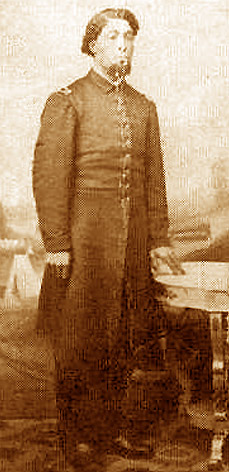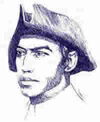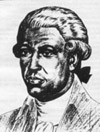Apparently the 31st USCT regiment that mustered in and trained on Hart Island had no Black commissioned officer. No listing for one has been found. The lack of one was not rare among USCT regiments. Although USCT regiments numbered close to 170, with troops numbering around 200,000, only about 120 Black commissioned officers were spread among them.
Benjamin Franklin Randolph
After his Civil War service, the Rev. Randolph, who was a "Freeborn" from Kentucky, went to South Carolina with the Freedmen's Bureau (official title: The Bureau of Refugees, Freedmen and Abandoned Lands).
The bureau, established in the War Department by an act of March 3, 1865, supervised all relief and educational activities relating to refugees and freedmen, including issuing rations, clothing and medicine and also assumed custody of confiscated property in the former Confederate States.
 In seeking a position with the Bureau, Randolph had written: In seeking a position with the Bureau, Randolph had written:
I am desirous of obtaining a position among the freedmen where my qualifications and experience will admit of the most usefulness. I don't ask position or money. But I ask a place where I can be most useful to my race. My learning and long experience as a teacher North, and my faithful service as Chaplain demand that I seek such a place. If you should obtain for me some responsible position in the Freedmen's Bureau...you would never regret it. -- B. F. Randolph
The "learning" his application cited would have included his education at Oberlin College, Ohio (1854-57, 1857-60).
Soon Randolph found where he could be "most useful to [his] race" -- playing a leading role in bringing about the first and only time in U.S. history that Black legislators outnumbered whites in any state legislature.
With Union military holding sway over South Carolina and with freed slaves voting for the first time, Blacks gained majority control in the legislature. Randolph was elected State Senator for Orangeburg County and served as state chairman of the Republican Party in South Carolina.
But, he was gunned down in broad daylight by three white men as he stepped from a train at Hodges Depot, Abbeville County, Friday, October 16, 1868.
He had been aware of, yet accepted, the mortal risks entailed in seeking to keep alive --despite the KKK terrorist violence -- the voting franchise so dearly and recently won by "freedmen."
Three years latter, 19 Black men founded in Columbia, S.C., the Randolph Cemetery (see images above) as a memorial to him. It was one of many cemeteries established in the South after the Civil War by African-Americans whose deceased were excluded from burial in "white" cemeteries. So Randolph's "usefulness" to his race continued even after his own death.
The inscription on the marker at the entrance to Randolph Cemetery (in the image above left) reads: In Memoriam, B. F. Randolph, Late Senator from Orangeburg District and Chairman, Republican State Central Committee, who died at Hodges Station, Abbeville District, at the hands of assassins on Friday, Oct. 16, A.D. 1868. The memorial cemetery is listed in the National Register of Historic Places. Information about Randolph can be found in Freedom's Lawmakers: A Directory of Black Officeholders During Reconstruction, New York: Oxford University Press, 1993.
George Washington LeVere
After his Civil War service, the Rev. LeVere became the first pastor Shiloh Presbyterian Church of Knoxville, TN. The date was Feb. 9, 1866. The church had been organized only five months earlier.
LeVere, born in Brooklyn and educated in schools there, had read theology under a Dr. Starrs and had served as a pastor and teacher in a day school under the auspices of the General Assembly for Freedmen.

|
|
Sketches of Prince Hall.
|

|
While LeVere served as Shiloh minister, the church purchased a lot at the corner of Henley St. and Clinch Ave. on which a frame building was erected on it at a cost of $3,300. When the congregation outgrew that building, a new one was erected in 1875.
Rev. LeVere served as the supervisor of the Shieldstown School on Linden Ave. He helped form the Colored Mechanics of Knoxville, serving as an officer.
Long active in Freemasonry among African Americans in Tennessee and elsewhere, he served as grand master of the National Grand Lodge, Free & Accepted Ancient York Rite Masons, Prince Hall Origin, National Compact, 1877-1886.
Prince Hall, one of Boston's most prominent citizens during the Revolutionary period, was the founder of the African Lodge of the Honorable Society of Free and Accepted Masons of Boston, the world's first lodge of black Freemasonry. He died in 1807 at the age of 72. A year later, his lodge honored him by changing its name to Prince Hall Grand Lodge. Most African American Freemasonry traces back to Prince Hall Lodge.
Rev. LeVere retired as Shiloh pastor in 1884 and died in 1886
.
|
